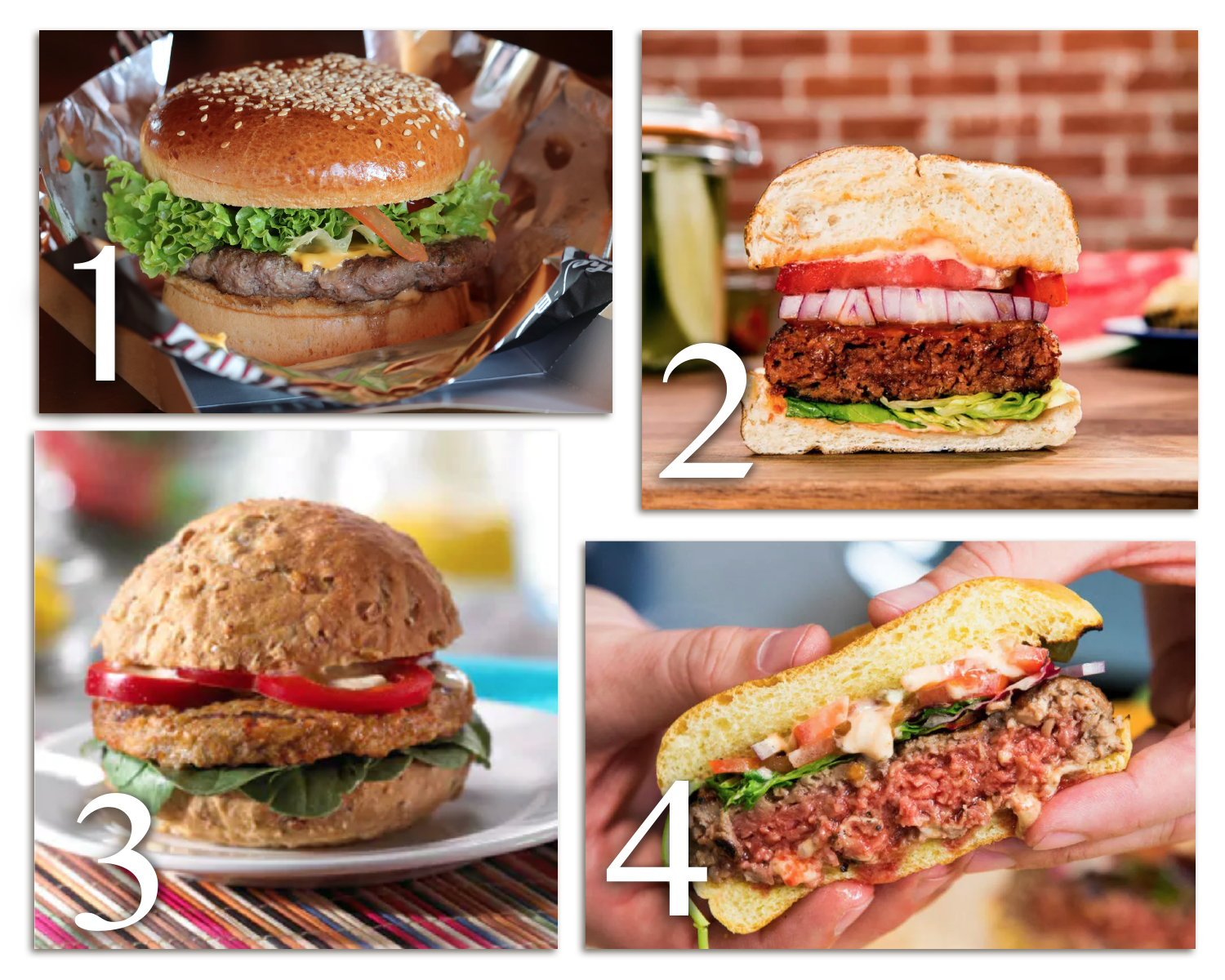A Tale of Two Burgers: Beef and Plant-based Protein
Students compare the components of beef and plant-based burgers by determining the production and processing methods of each product; evaluate the ingredients and nutritional differences between beef and plant-based products; and discuss different points of view in the agricultural industry concerning plant-based proteins and traditional beef. This lesson covers a socioscientific issue and aims to provide students with tools to evaluate science within the context of social and economic points of view.

Background
Lesson Activities
Recommended Companion Resources
Credits
Author
Bekka Israelsen | Utah Agriculture in the Classroom
Sources
- What's in a Name? In This Case, Quite a Bit | Dirt to Dinner
- Comparing Traditional & Alternative Burgers | Dirt to Dinner
- Home | Meat Institute
- Is a Plant-Based Diet Better for You? | Dirt to Dinner
- How Much Meat to Expect From a Beef Carcass PB1822.pdf | University of Tennessee Extension
- Impossible Foods Media Kit | Impossible Foods
- Impossible Foods
- Beyond Burger | Vegan Burger Patties | Beyond Meat
- July 4th Hot Dog and Hamburger Consumption by State | USA Today
- The History of the Veggie Burger | Smithsonian Magazine
- How do you make heme? | Impossible Foods
- What are the ingredients in Impossible™ Beef Meat From Plants? | Impossible Foods
- What are the nutrition facts for Impossible™ Beef Meat From Plants? | Impossible Foods
- Great Value Beef Burgers 85% Lean/15% Fat, 12ct, 3 lb (Frozen) | Walmart
Standards
Texas Content Area Standards
-
Principles of Agriculture, Food, and Natural Resources: 130.2.c.1
The student demonstrates professional standards/employability skills as required by business and industry. The student is expected to:
- Principles of Agriculture, Food, and Natural Resources: 130.2.c.1.B: apply competencies related to resources, information, interpersonal skills, problem solving, critical thinking, and systems of operation in agriculture, food, and natural resources.
-
Principles of Agriculture, Food, and Natural Resources: 130.2.c.4
The student explains the historical, current, and future significance of the agriculture, food, and natural resources industry. The student is expected to:
- Principles of Agriculture, Food, and Natural Resources: 130.2.c.4.B: analyze the scope of agriculture, food, and natural resources and its effect upon society.
- Principles of Agriculture, Food, and Natural Resources: 130.2.c.4.C: evaluate significant historical and current agriculture, food, and natural resources developments.
- Principles of Agriculture, Food, and Natural Resources: 130.2.c.4.E: describe how emerging technologies and globalization impacts agriculture, food, and natural resources.
- Principles of Agriculture, Food, and Natural Resources: 130.2.c.4.F: compare and contrast issues impacting agriculture, food, and natural resources such as biotechnology, employment, safety, environment, and animal welfare issues.
-
Principles of Agriculture, Food, and Natural Resources: 130.2.c.6
The student demonstrates appropriate personal and communication skills. The student is expected to:
- Principles of Agriculture, Food, and Natural Resources: 130.2.c.6.A: demonstrate written and oral communication skills appropriate for formal and informal situations such as prepared and extemporaneous presentations.
- Principles of Agriculture, Food, and Natural Resources: 130.2.c.6.B: demonstrate effective listening skills appropriate for formal and informal situations.
-
Principles of Agriculture, Food, and Natural Resources: 130.2.c.13
The student describes the principles of food products and processing systems. The student is expected to:
- Principles of Agriculture, Food, and Natural Resources: 130.2.c.13.A: evaluate food products and processing systems.
- Principles of Agriculture, Food, and Natural Resources: 130.2.c.13.B: determine trends in world food production.
- Principles of Agriculture, Food, and Natural Resources: 130.2.c.13.C: discuss current issues in food production.
-
English I: 110.36.c.1
Developing and sustaining foundational language skills: listening, speaking, discussion, and thinking--oral language. The student develops oral language through listening, speaking, and discussion.
- English I: 1.A: The student is expected to engage in meaningful and respectful discourse by listening actively, responding appropriately, and adjusting communication to audiences and purposes.
- English I: 1.B: The student is expected to follow and give complex oral instructions to perform specific tasks, answer questions, or solve problems and complex processes.
- English I: 1.C: The student is expected to give a presentation using informal, formal, and technical language effectively to meet the needs of audience, purpose, and occasion, employing eye contact, speaking rate such as pauses for effect, volume, enunciation, purposeful gestures, and conventions of language to communicate ideas effectively.
- English I: 1.D: The student is expected to participate collaboratively, building on the ideas of others, contributing relevant information, developing a plan for consensus building, and setting ground rules for decision making.
-
English I: 110.36.c.11
Inquiry and research: listening, speaking, reading, writing, and thinking using multiple texts. The student engages in both short-term and sustained recursive inquiry processes for a variety of purposes.
- English I: 11.A: The student is expected to develop questions for formal and informal inquiry.
- English I: 11.E: The student is expected to locate relevant sources.
- English I: 11.F: The student is expected to synthesize information from a variety of sources.
- English I: 11.G.i: The student is expected to examine sources for credibility and bias, including omission.
- English I: 11.I: The student is expected to use an appropriate mode of delivery, whether written, oral, or multimodal, to present results.
-
English I: 110.36.c.4
Comprehension skills: listening, speaking, reading, writing, and thinking using multiple texts. The student uses metacognitive skills to both develop and deepen comprehension of increasingly complex texts.
- English I: 4.G: The student is expected to evaluate details read to determine key ideas.
- English I: 4.H: The student is expected to synthesize information from two texts to create new understanding.
-
English I: 110.36.c.5
Response skills: listening, speaking, reading, writing, and thinking using multiple texts. The student responds to an increasingly challenging variety of sources that are read, heard, or viewed.
- English I: 5.D: The student is expected to paraphrase and summarize texts in ways that maintain meaning and logical order.
-
English II: 110.37.c.4
Comprehension skills: listening, speaking, reading, writing, and thinking using multiple texts. The student uses metacognitive skills to both develop and deepen comprehension of increasingly complex texts.
- English II: 4.G: The student is expected to evaluate details read to determine key ideas.
- English II: 4.H: The student is expected to synthesize information from multiple texts to create new understanding.
-
English II: 110.37.c.1
Developing and sustaining foundation language skills: listening, speaking, discussion, and thinking--oral language. The student develops oral language through listening, speaking, and discussion.
- English II: 1.A: The student is expected to engage in meaningful and respectful discourse by listening actively, responding appropriately, and adjusting communication to audiences and purposes.
- English II: 1.B: The student is expected to follow and give complex oral instructions to perform specific tasks, answer questions, or solve problems and complex processes.
- English II: 1.C: The student is expected to give a formal presentation that incorporates a clear thesis and a logical progression of valid evidence from reliable sources and that employs eye contact, speaking rate such as pauses for effect, volume, enunciation, purposeful gestures, and conventions of language to communicate ideas effectively.
- English II: 1.D: The student is expected to participate collaboratively, building on the ideas of others, contributing relevant information, developing a plan for consensus building, and setting ground rules for decision making.
-
English III: 110.38.c.1
Developing and sustaining foundational language skills: listening, speaking, discussion, and thinking--oral language. The student develops oral language through listening, speaking, and discussion.
- English III: 1.A: The student is expected to engage in meaningful and respectful discourse when evaluating the clarity and coherence of a speaker's message and critiquing the impact of a speaker's use of diction and syntax.
- English III: 1.B: The student is expected to follow and give complex instructions, clarify meaning by asking pertinent questions, and respond appropriately.
- English III: 1.C: The student is expected to give a formal presentation that exhibits a logical structure, smooth transitions, accurate evidence, well-chosen details, and rhetorical devices and that employs eye contact, speaking rate such as pauses for effect, volume, enunciation, purposeful gestures, and conventions of language to communicate ideas effectively.
- English III: 1.D: The student is expected to participate collaboratively, offering ideas or judgements that are purposeful in moving the team toward goals, asking relevant and insightful questions, tolerating a range of positions and ambiguity in decision making, and evaluating the work of the group based on agreed-upon criteria.
-
English III: 110.38.c.4
Comprehension skills: listening, speaking, reading, writing, and thinking using multiple texts. The student uses metacognitive skills to both develop and deepen comprehension of increasingly complex texts.
- English III: 4.G: The student is expected to evaluate details read to understand key ideas.
- English III: 4.H: The student is expected to synthesize information from a variety of text types to create new understanding.
-
English II: 110.37.c.11
Inquiry and research: listening, speaking, reading, writing, and thinking using multiple texts. The student engages in both short-term and sustained recursive inquiry processes for a variety of purposes.
- English II: 11.A: The student is expected to develop questions for formal and informal inquiry.
- English II: 11.E: The student is expected to locate relevant sources.
- English II: 11.F: The student is expected to synthesize information from a variety of sources.
- English II: 11.G.i: The student is expected to examine sources for credibility and bias, including omission.
- English II: 11.I: The student is expected to use an appropriate mode of delivery, whether written, oral, or multimodal, to present results.
-
English III: 110.38.c.5
Response skills: listening, speaking, reading, writing, and thinking using multiple texts. The student responds to an increasingly challenging variety of sources that are read, heard, or viewed.
- English III: 5.D: The student is expected to paraphrase and summarize texts in ways that maintain meaning and logical order.
-
English II: 110.37.c.5
Response skills: listening, speaking, reading, writing, and thinking using multiple texts. The student responds to an increasingly challenging variety of sources that are read, heard, or viewed.
- English II: 5.D: The student is expected to paraphrase and summarize texts in ways that maintain meaning and logical order.
-
English III: 110.38.c.11
Inquiry and research: listening, speaking, reading, writing, and thinking using multiple texts. The student engages in both short-term and sustained recursive inquiry processes for a variety of purposes.
- English III: 11.A: The student is expected to develop questions for formal and informal inquiry.
- English III: 11.E: The student is expected to locate relevant sources.
- English III: 11.F: The student is expected to synthesize information from a variety of sources.
- English III: 11.G.i: The student is expected to examine sources for credibility, bias, and accuracy.
- English III: 11.I: The student is expected to use an appropriate mode of delivery, whether written, oral, or multimodal, to present results.
-
English IV: 110.39.c.1
Developing and sustaining foundational language skills: listening, speaking, discussion, and thinking--oral language. The student develops oral language through listening, speaking, and discussion.
- English IV: 1.A: The student is expected to engage in meaningful and respectful discourse when evaluating the clarity and coherence of a speaker's message and critiquing the impact of a speaker's use of diction, syntax, and rhetorical strategies.
- English IV: 1.B: The student is expected to follow and give complex instructions, clarify meaning by asking pertinent questions, and respond appropriately.
- English IV: 1.C: The student is expected to formulate sound arguments and present using elements of classical speeches such as introduction, first and second transitions, body, conclusion, the art of persuasion, rhetorical devices, employing eye contact, speaking rate such as pauses for effect, volume, enunciation, purposeful gestures, and conventions of language to communicate ideas effectively.
- English IV: 1.D: The student is expected to participate collaboratively, offering ideas or judgements that are purposeful in moving the team toward goals, asking relevant and insightful questions, tolerating a range of positions and ambiguity in decision making, and evaluating the work of the group based on agreed-upon criteria.
-
English IV: 110.39.c.4
Comprehension skills: listening, speaking, reading, writing, and thinking using multiple texts. The student uses metacognitive skills to both develop and deepen comprehension of increasingly complex texts.
- English IV: 4.H: The student is expected to synthesize information from a variety of text types to create new understanding.
-
English IV: 110.39.c.5
Response skills: listening, speaking, reading, writing, and thinking using multiple texts. The student responds to an increasingly challenging variety of sources that are read, heard, or viewed.
- English IV: 5.D: The student is expected to paraphrase and summarize texts in ways that maintain meaning and logical order.
-
English IV: 110.39.c.11
Inquiry and research: listening, speaking, reading, writing, and thinking using multiple texts. The student engages in both short-term and sustained recursive inquiry processes for a variety of purposes.
- English IV: 11.A: The student is expected to develop questions for formal and informal inquiry.
- English IV: 11.E: The student is expected to locate relevant sources.
- English IV: 11.F: The student is expected to synthesize information from a variety of sources.
- English IV: 11.G.i: The student is expected to examine sources for credibility, bias, and accuracy.
- English IV: 11.I: The student is expected to use an appropriate mode of delivery, whether written, oral, or multimodal, to present results.
-
Environmental Systems: 112.37.c.9
Science concepts. The student knows the impact of human activities on the environment.
- Environmental Systems: 9.G: The student is expected to analyze how ethical beliefs can be used to influence scientific practices such as methods for increasing food production.
-
Food Technology and Safety: 130.15.c.3
The student explains the impact of food science systems. The student is expected to:
- Food Technology and Safety: 130.15.c.3.A: explain the significance of food science systems.
- Food Technology and Safety: 130.15.c.3.B: define trends in food production, world population, and supply and demand for food products.
- Food Technology and Safety: 130.15.c.3.C: research trends in animal and food science research.
-
Food Technology and Safety: 130.15.c.7
The student demonstrates an understanding of the trends and issues important to careers in the food science industry by comparing and contrasting issues affecting the food science industry, including biotechnology, employment, safety, environmental, and animal welfare issues. The student is expected to:
- Food Technology and Safety: 130.15.c.7.A: select solutions for different environmental issues.
- Food Technology and Safety: 130.15.c.7.B: identify issues affecting food science.
- Food Technology and Safety: 130.15.c.7.C: research history and policies related to food science issues.
-
Food Technology and Safety: 130.15.c.8
The student describes the processing, packaging, quality analysis, and marketing of red meats and their by-products. The student is expected to:
- Food Technology and Safety: 130.15.c.8.E: identify methods of fabricating and marketing processed meats.
-
Food Processing: 130.16.c.3
The student knows the relationship of the food processing industry to the free enterprise system. The student is expected to:
- Food Processing: 130.16.c.3.B: explain trends in the consumption of food products.
-
Food Processing: 130.16.c.4
The student understands consumer satisfaction issues. The student is expected to:
- Food Processing: 130.16.c.4.B: explain the factors that affect food palatability.
-
Environmental Systems: 112.50.c.12
Science concepts. The student understands how ethics and economic priorities influence environmental decisions. The student is expected to:
- Environmental Systems: 112.50.c.12.C: analyze how ethical beliefs influence environmental scientific and engineering practices such as methods for food production, water distribution, energy production, and the extraction of minerals




